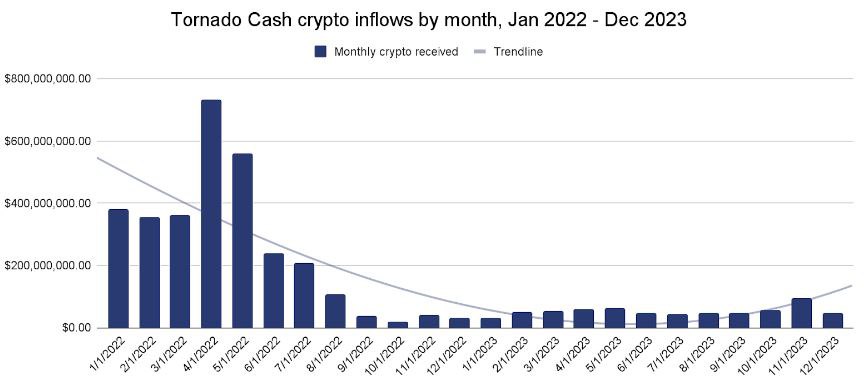ARTICLE AD BOX
Following sanctions in August 2022 for laundering over $455 million in stolen crypto assets by the Lazarus Group, controversial coin mixer Tornado Cash faced a major setback. Despite OFAC’s delisting and redesignation in November, its decentralized setup made it immune to physical shutdown.
Chainalysis’s data, shared with CryptoPotato, showed a 93% drop in monthly inflows post-sanctions compared to pre-sanctions averages.
Tornado Cash Bounces Back Despite Initial Setback
Since the OFAC sanctions on Tornado Cash, inflows on the tumbler have risen by 28%, totaling $822.0 million, as per the blockchain intelligence firm’s latest findings. Yet, compared to the period before the sanctions, inflows have decreased by 89.2%, highlighting the impact.
The amount of illegal transactions linked to sanctions has been increasing steadily in recent years. This is because more entities are being sanctioned, and it’s also harder to enforce them on entities in regions that don’t follow OFAC’s rules or on decentralized operations.
“It’s still worth watching Tornado Cash as its continued activity in the last year highlights the challenge of enforcing sanctions on decentralized entities, while also demonstrating the efficacy of sanctions and reinforcing the need for regulation in the DeFi ecosystem.”
 Tornado Cash Crypto Inflows. Source: Chainalysis
Tornado Cash Crypto Inflows. Source: ChainalysisIn 2023, the OFAC imposed 18 sanctions on entities using crypto addresses. Chainalysis identified crypto addresses linked to OFAC-designated entities, including Trickbot ransomware gang members. They received 61.5% of illicit transaction volume, totaling $14.9 billion last year.
Unlike in 2022, OFAC targeted mainly groups and individuals in 2023, except for Genesis Market and Sinbad.io. Previous sanctions in 2022 focused on major services like Garantex, Hydra, Tornado Cash, and Blender.io, indicating a shift in OFAC’s crypto-related targets.
Crypto-Related Sanctions Activity
Since 2022, crypto transactions linked to sanctioned entities remained significant. Notably, Garantex and Tornado Cash contributed to this high volume. However, crypto sent to sanctioned regions has declined since the peak of the 2021 bull market.
In 2023, the top five sanctioned entities collectively received $821.4 million in crypto, with Sinbad.io leading at $665.4 million. Sanctions mainly targeted smaller entities and individuals rather than major services.
Last year, there was a significant surge in crypto-related sanctions associated with OFAC’s illicit drugs program, marking a four-fold increase compared to 2022. Sanctions targeting North Korea (DPRK2-4) and cybercriminals (CYBER2) also increased.
As a result of the ongoing fentanyl crisis in the United States, drug-related sanctions took precedence, with OFAC introducing nine fentanyl-related sanctions, highlighting an increased focus on combating drug-related activities facilitated through crypto.
The post Chainalysis Data Reveals 93% Drop in Tornado Cash Inflows Post-Sanctions appeared first on CryptoPotato.
.png)
 9 months ago
6
9 months ago
6








 English (US)
English (US)